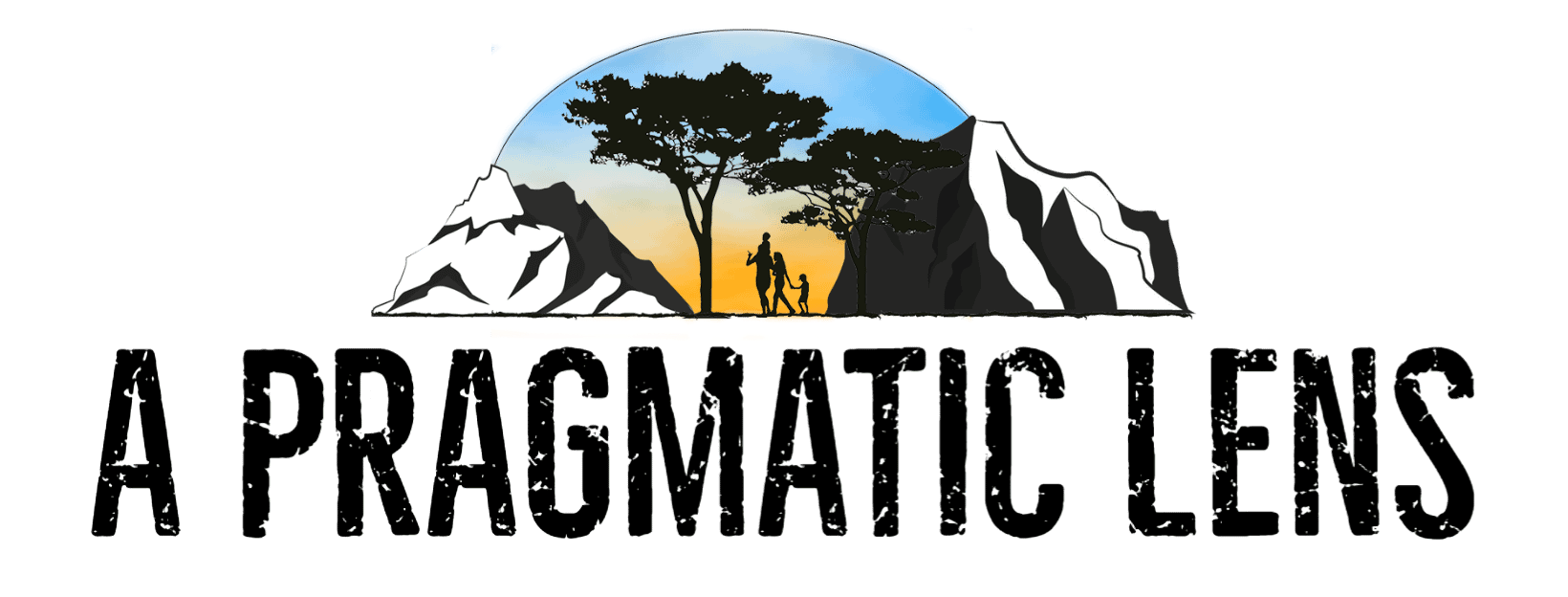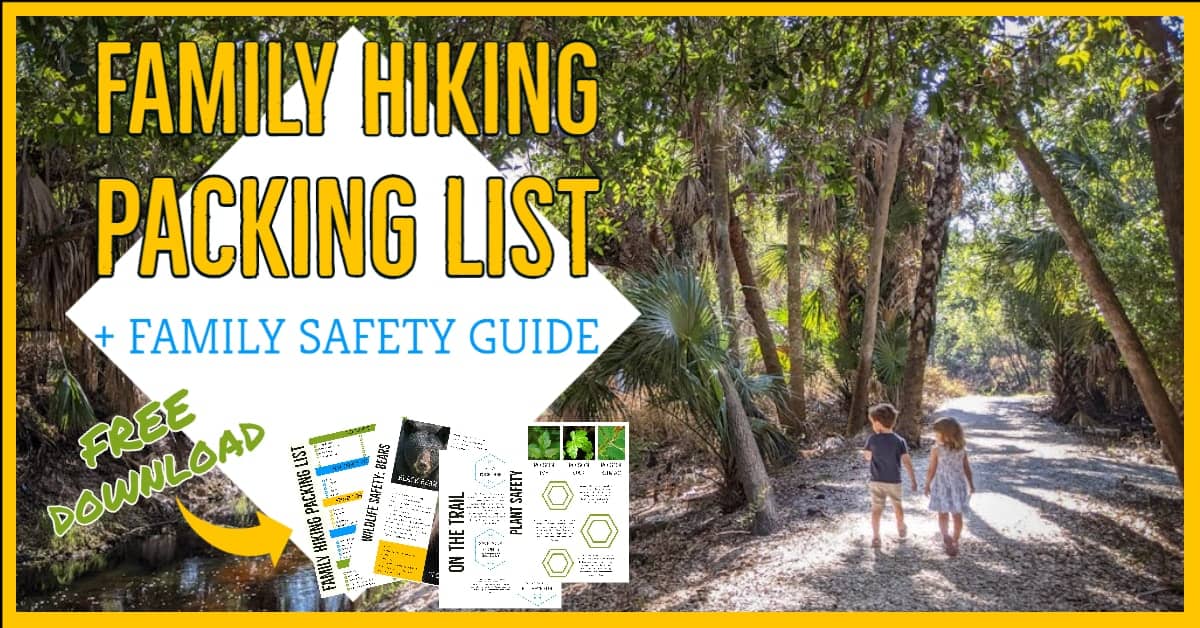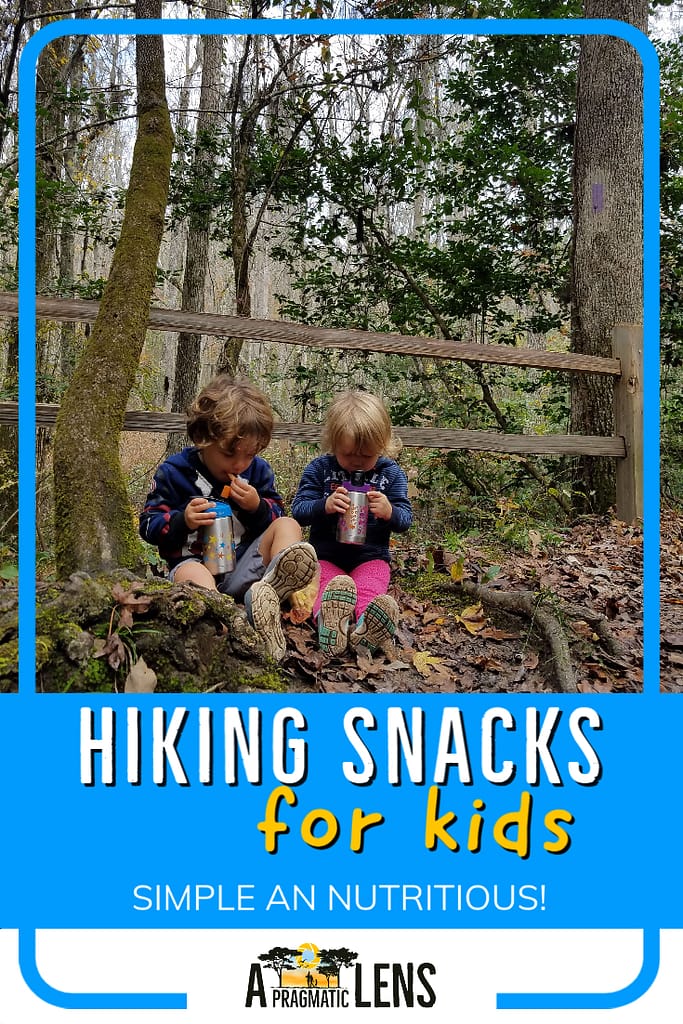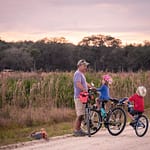Do you know the fastest way to end up with a cranky kid on the trail?
You guessed it.
HUNGER.
So, you know you need to bring food with you, and if you are here, that means you would like some ideas to inspire you. I am all about practical solutions to make outdoor activities happen, so in this post I list out the best hiking snacks for families that are easy to pack and nutritious!
This post may contain affiliate links. Visit the Disclaimer page for more information.
Hiking is such a great outdoor family activity! It is accessible for many families, it allows kids to explore nature at their pace, and you do not need expensive gear. Still, because going on a nature walk is essentially a physical activity, you need to make sure yourself and your family are properly nourished while you are out!
Of course, you know this, and that is why you are here…so let’s dive right into the best snacks for family hikes! Later on, I will explain why I think these are great, and also give you ideas on how to pack them.
Here we go!

Related: Easy Family Outdoor Activities at Home or Near
The Best Hiking Snacks for Families
Easy Veggies
Vegetables are amazing sources of electrolytes, vitamins, and complex sugars that will help fuel your body during a hike. You can bring a veggie dip or hummus to go along with these to make them more kid-friendly. Hummus will provide a nice burst of proteins as well!
Here as some easy veggies to pack:
Carrots
You can buy baby carrots or carrot chips. I personally prefer buying them whole and cutting them lenght-wise into sticks. Not only is it more cost effective, but I also feel they are more flavorful that way.
Snap peas
These are so convenient, since you can buy a large bag and there’s no more pre-work needed. They also do not take much space at all!
Celery
You can buy celery sticks already cut, or get a large stalk and cut it yourself. I am not a fan of the celery strings, but one thing that I found helps is cutting the celery length-wise to make them thinner. This makes it a lot easier to eat!
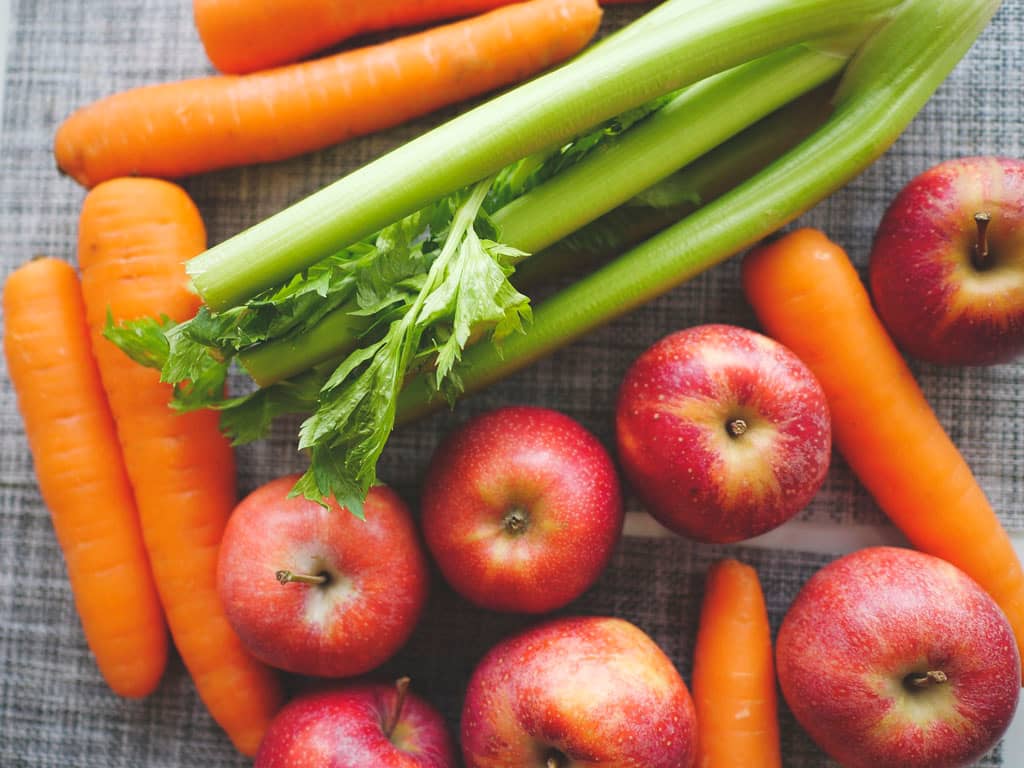
Fresh Fruits
Bananas
Bananas are great source of simple sugars to give you energy, as well as electrolytes such as potassium and magnesium. Kids generally enjoy bananas, and they are easy to pack. No plastic waste here!
Frozen Grapes
Another great source of simple sugars, B vitamins, and fiber. Because of the water content, grapes are also a hydrating treat. You freeze them the night before, and toss them in a lunch bag the next day. Freezing them makes them sweeter, and I am sure your kids will not complain about that!
Cut up apples
Apples are rich in both simple sugars and fiber, as well as vitamins and potassium. You can pack them whole, although I prefer to cut them up in wedges to save space in my bag. Dipping them in a bit of lemon juice before packing them will reduce browning.
Mandarins And Oranges
Mandarins are generally small and rather easy to pack. They do not need refrigeration, although eating cold mandarins feels great on a hot day! Oranges are larger, so I do cut them up in wedges and pack them that way.
Both oranges and mandarins pack a bunch of simple sugars, fiber, and vitamin C, along with other essential nutrients.
Store-bought Hiking Snacks
I normally avoid store bought snacks to reduce waste from the packaging, but they do come in handy when traveling and camping.
Granola and energy bars
Granola bars are great for hiking snacks, but make sure you are looking for the right kind. Take a look at the ingredients. Avoid bars with added sugars or with added flavors. Instead, opt for ones that use dried fruit to add sweetness. Also, look for bars that use whole grains, and do not worry about bars having a large amount of protein.
PEANUT BUTTER PRETZELS
Peanut butter-filled pretzels are easy-to-pack and yummy! They provide a combination of simple sugars, protein, and electrolytes. They are also filling, so they will keep your family moving for a good amount of time!
Applesauce pouches
I usually avoid applesauce packets to reduce waste. When camping or traveling, however, I buy the pouches from the store. They are a great way to give kids a bit of energy, hydration, and electrolytes. And kids just love these!
Easy Homemade Snacks
DIY TRAIL MIX
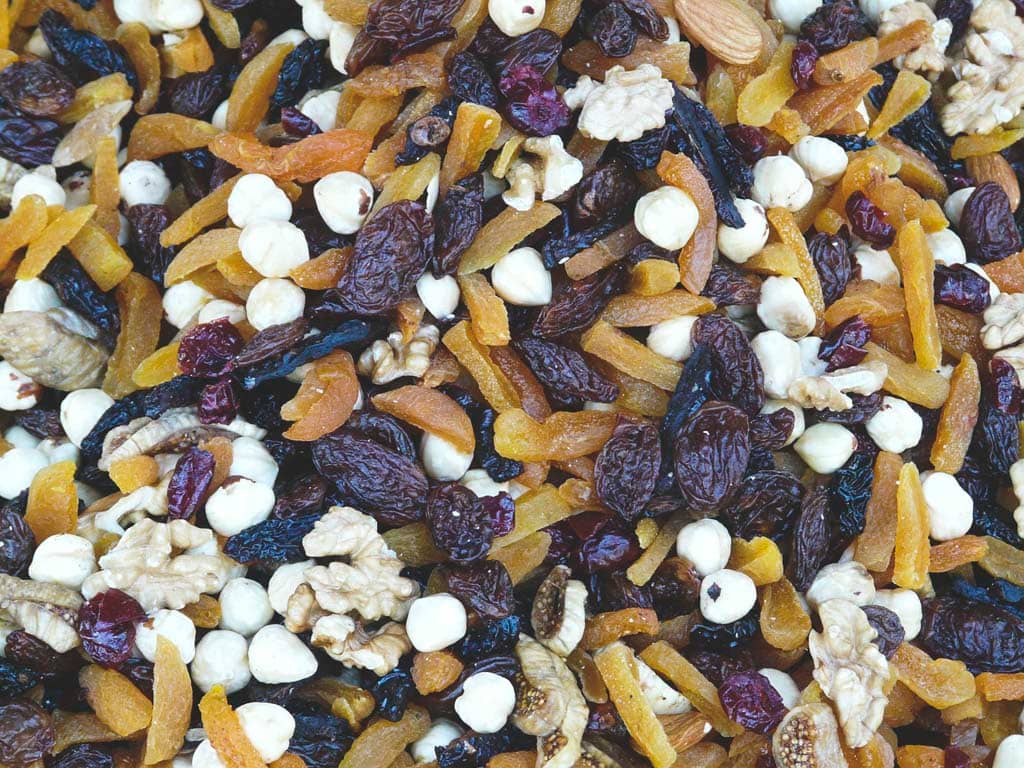
You can buy trail mix, but making your own is SO easy and cost-effective. Here are ideas to add:
- Nuts: Cashews, peanuts, walnuts, almonds. All packed with essential fatty acids, protains, and complex carbs
- Nut-free: For nut-free options, you can go for seeds, such as pumpkin and sunflower seeds.
- Dried fruit: raisins, craisins, banana chips, figs, apricots, peaches.
- Whole grains: whole grain chex cereal, granola
- Other: You can add other things for a twist, such as pretzels, coconut flakes, or dark chocolate,
There are no rules for how much to add of each ingredient. That is entirely up to you, and you can switch things around each time you go hiking with your kids! Just in case, here is an article with trail recipe options for you 🙂
Energy bites
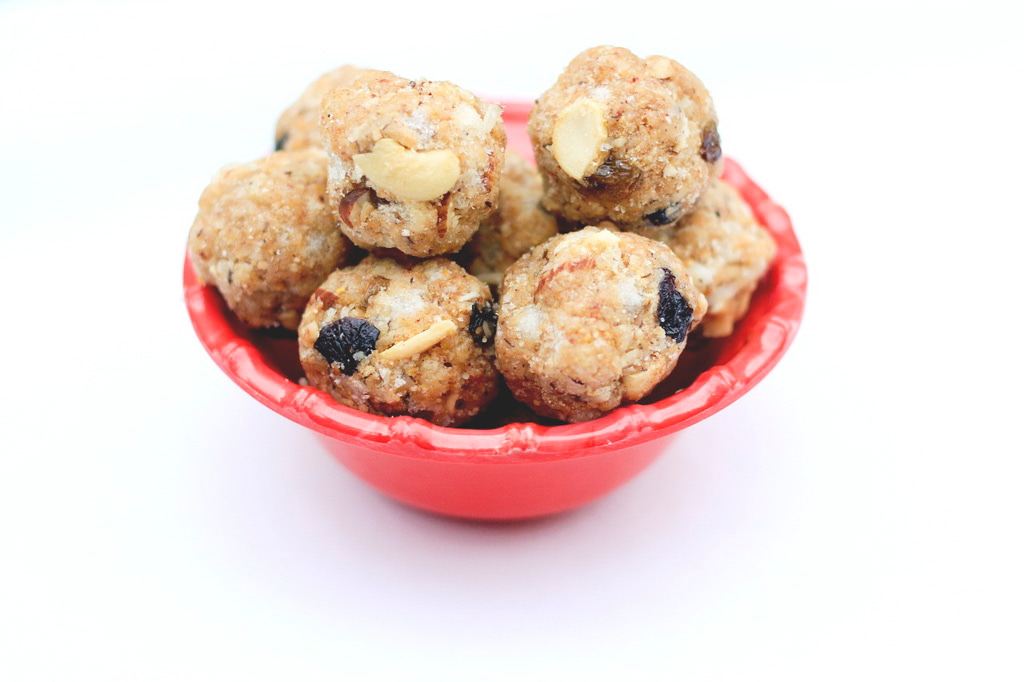
What I love about energy bites is that they are packed with energy (duh!) and nutrients. And…no baking is necessary!
They are also filling, and your kids will think this is the best hiking treat in the world! Talk about something to keep your kids motivated on the trail, right?
These little balls of goodness can be made ahead of time and kept refrigerated until you are ready to use them for your hike. I am not a recipe person, but you can find good energy bite recipes here.
salmon tortillas
We usually eat plant-based foods, but we are not exclusive vegetarians (although I was a strict vegetarian for 14 years!). I do like to incorporate fish about one per week, and my go-to choice is salmon. Because they are lower on the food chain, they do not accumulate as much mercury as tuna does.
I don’t generally make these for short hikes, but they are great on days I know we will be out longer than usual.
I basically make a salmon version of a tuna salad, mixing canned salmon with some mayo, sunflower seeds, and chopped celery and onions. I wrap a tortilla around them and cut the tortilla in bite-sized circles. Easy and complete lunch!
homemade granola Bars
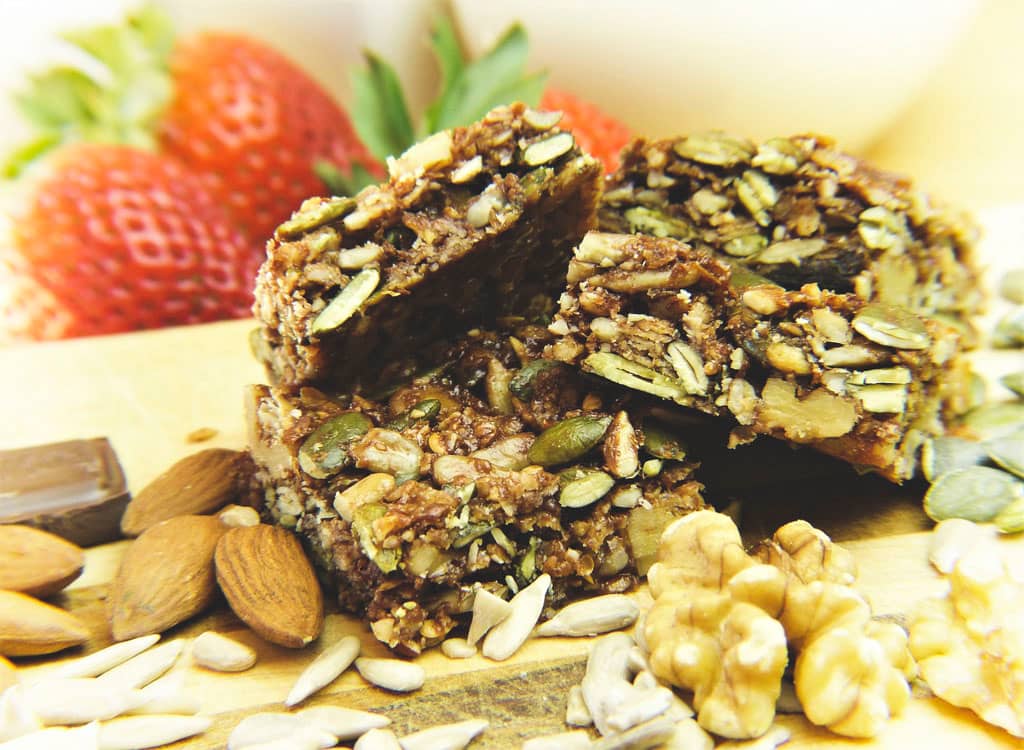
I am too lazy to make granola bars, but I think they are a great and cost-effective alternative to store-bought granola bars. Just like with the energy bites, you can add multiple different nutrient-rich ingredients such as oats, seeds, nut butter (or alternatives), and dried fruit. Here is a simple 5-ingredient granola bar recipe if you want to give this a try!
Roasted chickpeas
These are awesome. Not only are garbanzo beans full of fiber and protein, but they also contain potassium, B vitamins, and calcium. You can roast the chickpeas with almost any spice, but here are a few recipes for you:
Smoothies
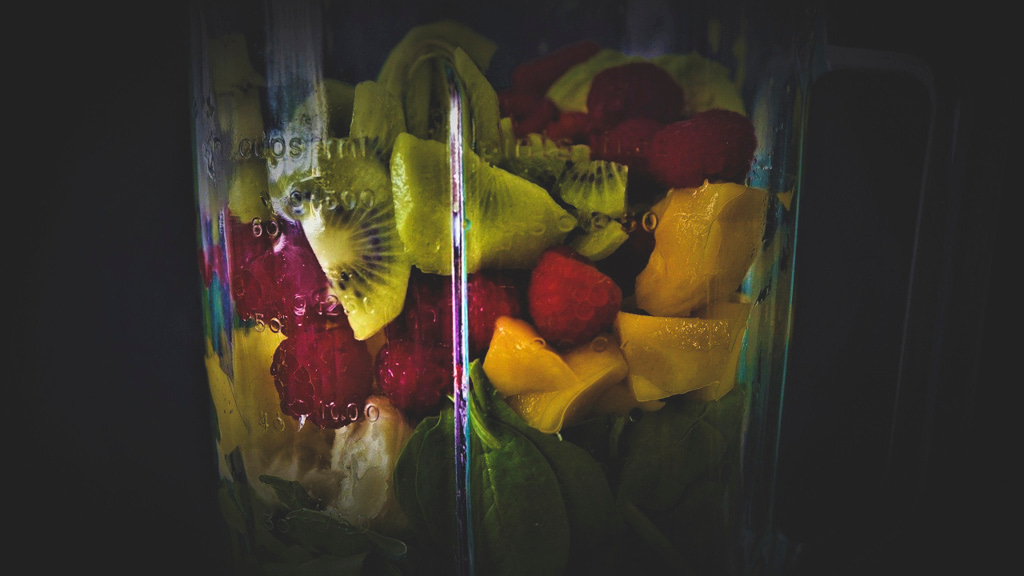
Smoothies are a great way to incorporate nutrients, vitamins, and hydration. There are many recipes online, but here’s what I add to my kids’ smoothies:
- Low fat greek yogurt
- Soy milk – to keep the smoothie, well, smooth.
- Vegetables – beets and spinach work quite well
- Frozen fruits – I buy the froze fruit bags, but you can use fresh fruit as well. I usually like to do berries.
- Seeds – I add chia, hemp, and flax
If the hike is short, I leave the smoothies in the car in a small cooler. For longer hikes, you may want to bring them with you and keep them cool. More on how to pack your snacks below.
Nut-Free Hiking snacks
Most of the hiking snacks I suggest here are nut-free! And others can be made nut-free by substituting nut butters for seed butters, such as sunflower seed butter, granola butter, or soy butter!
Related: How to Avoid Dangerous Wildlife Encounters while Hiking with Kids
What makes a good hiking snack?
Sure, you could disregard all the options I suggested above, grab a bag of Cheetos and call that good.
I wouldn’t complain much… I LOVE Cheetos!
However, I think it goes without saying that Cheetos is not a particularly good source of nutrients.
So what should you look for in a hiking snack?
Nutrients
Carbohydrates
Keto diet followers are probably revolting at the mention of carbs….but, you should be consuming them, and the trick is selecting the right carbs.
As explained in this article about carbohydrates from the American Heart Association, carbohydrates are the main source of fuel for your muscles. If you do not provide an adequate supply of carbohydrates, then your glycogen stores will be depleted and you will feel drained out of energy…that is not what you want, right?
Not to mention, tired kids are NO FUN in general, but especially on a trail!
Ideally, you will include a combination of simple sugars that are easier to process, such as those in fruit, with complex carbohydrates that take a bit longer to process. Now we are talking about whole grains.
Fats
Eating the right fats is an essential part of a healthy diet. We need food to provide essential fatty acids that our bodies cannot produce on their own. We also need fats to help us absorb nutrients.
While all fats have the same caloric amount regardless of the type, some fats are much healthier than other. Without a doubt, eating fats that promote cardiovascular health is essential for a physical activity such as hiking!
Once again, I rely on the American Heart Association to provide the most reliable information on what sorts of fats you should be consuming:
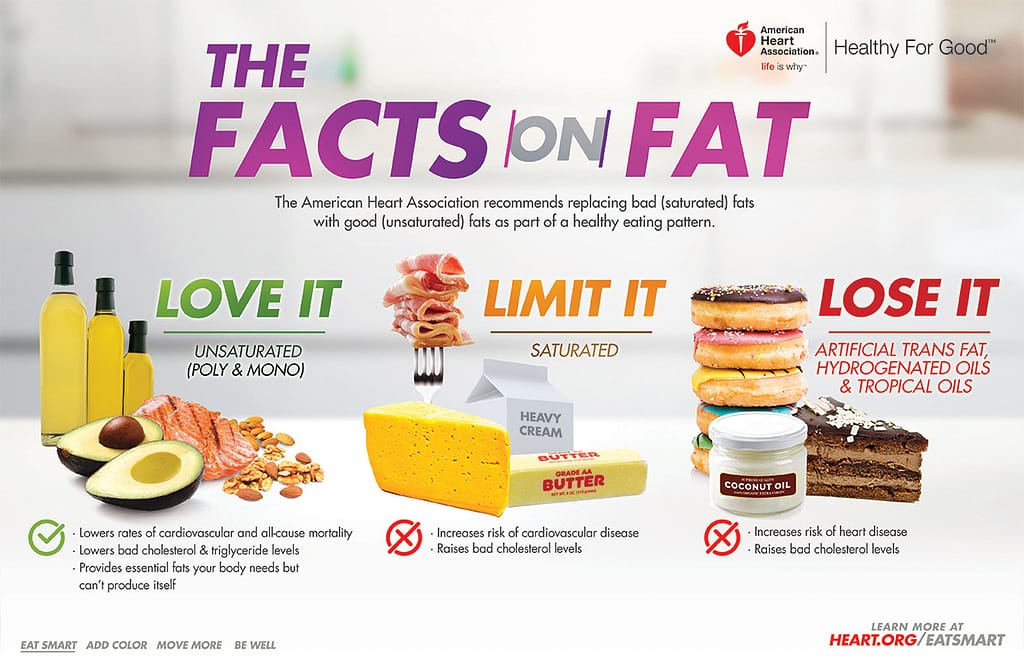
Proteins
There is no doubt that proteins are an important part of an active lifestyle, but you do not need loads of it during a hike.
Let me put on my biology instructor hat on and give you a quick lesson.
In muscle cells, thick and thin filaments made up of proteins (actin and myosin) are responsible for the cells ability to contract and expand, allowing for movement (U.S. National Library of Medicine).
During physical activity, some of those structures may become damaged and need to be replaced with more protein. Now, proteins are chains of amino acids. There are 20 different amino acids, and people in good health are capable of making 11 of those. The other 9 amino acids, called essential amino acids, must be obtained from food.
Does this mean you need to load up on beef jerky during a hike? Probably not. As long as you are getting an adequate intake of protein throughout your day, then you should be golden!
Electrolytes
Electrolytes are minerals that conduct electrical charges when mixed with water. They are essential for muscle function and for the nervous system to work properly.
Electrolyte imbalance is of particular concern during hot day/ This is because when you sweat, you lose electrolytes along with water.
This is why, in addition to water, you need an adequate supply of foods with the right electrolytes. On days where you will be out with your family for long periods in the heat (not recommended), you can also use electrolyte powders to mix in with your water.
Easy to pack
When it comes to hiking with kids, you are probably carrying extra waters, maybe even diaper, baby wipes, and other hiking supplies (see the last section to learn more about this). You will need to be efficient in the items you bring and the way you pack.
Hiking snacks that take up a small amount of space are ideal in that sense. I love snacks that can be stored mostly snack, as these are the easiest ones to pack.
Low Waste
This is my own requirement. One of the reasons we go on family hikes is to expose our kids to nature. I want them to learn about it and learn how to protect it. I feel I send the wrong message if I am also creating a load of garbage every time we go out.
While creating waste is sometimes inevitable, it can certainly be minimized by choosing hiking snacks that can go in reusable containers.
How to pack your snacks for Hiking
It goes without saying that you want to choose containers and lunch bags that are lightweight and that save space. Below are the items I use, and not just for hiking. These are the lunch bags and containers that my kids take to school as well. Quite versatile!
Reusable Silicone Bags
These reusable silicone food storage bags will effectively replace Ziploc bags. I use these not just for snacks, but also for general food storage at home or camping. They seal very well, and many times I store juicy foods and even soups! They wash quite well in the dishwasher and store flat when not in use.
The smaller version is fantastic for hiking because their flat shape will easily fit in your bag or backpack. My only complaint is that the small snack-sized ones do not close well for some reason. It still works for us, and I can fill them up with roasted chickpeas, trail mix, fruit, vegetables, you name it!
If you do not want to deal with that issue, these are other food storage silicone bags that you may want to consider.
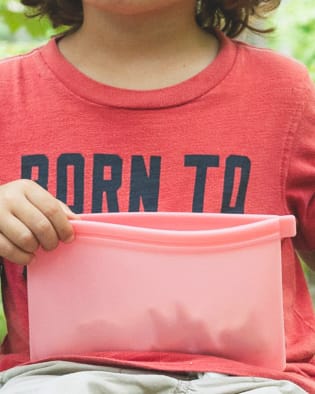
Related: 51 Best Gifts for Outdoorsy Kids
Small lunch bag
For those times when you think you will be out for a long time and need extra food, then you may need to bring a lunch bag. My favorites, by far, are neoprene bags such as this one. They are washable and store flat. In case you haven’t noticed, I love things that store flat…
Do be aware that, although neoprene bags can keep your items cool with an ice pack (check out these flat ice packs!!), they will not do so for more than 3-4 hours depending on the heat. If you will be hiking for longer than that and your food needs to be kept cold, then I suggest using a PackIt lunch box.
Reusable Smoothie Pouch
These reusable baby food pouches are probably my favorite snack-related purchase of all time! I use them for applesauce and smoothies instead of having to purchase applesauce pouches from the store. The ones I have I purchased over three years ago and they are still going strong with almost daily use!
The pouches have a control valve that keeps the smoothie from spilling all over and can hold over 6 oz of food (store-bought pouches hold, at most, 4oz). They are small, light-weight, and dishwasher safe. I use these for almost any outing we do, for school playground, and of course, hikes!
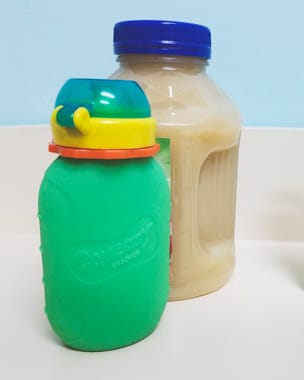
What else should you pack in your hiking backpack?
In addition to food and water, make sure you have first aid items, sunscreen, bug spray, navigation tools, and other safety equipment with you.
I will go into detail on hiking essentials on a separate post. In the meantime, I suggest you download this free printable pack that includes a family hiking packing list and comprehensive family hiking safety tips!
Last Thoughts
Hiking snacks do not need to be complicated or expensive to be delicious and nutritious. Keep it simple and enjoy your day out with your kids!
What do you like to bring on hikes with your kids?

